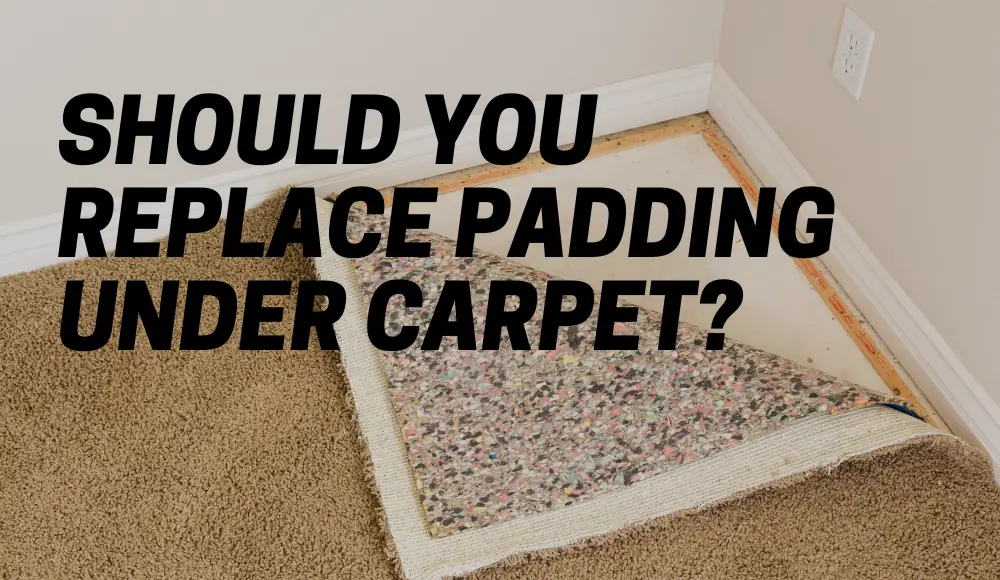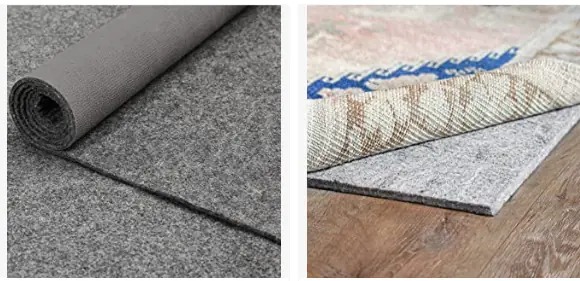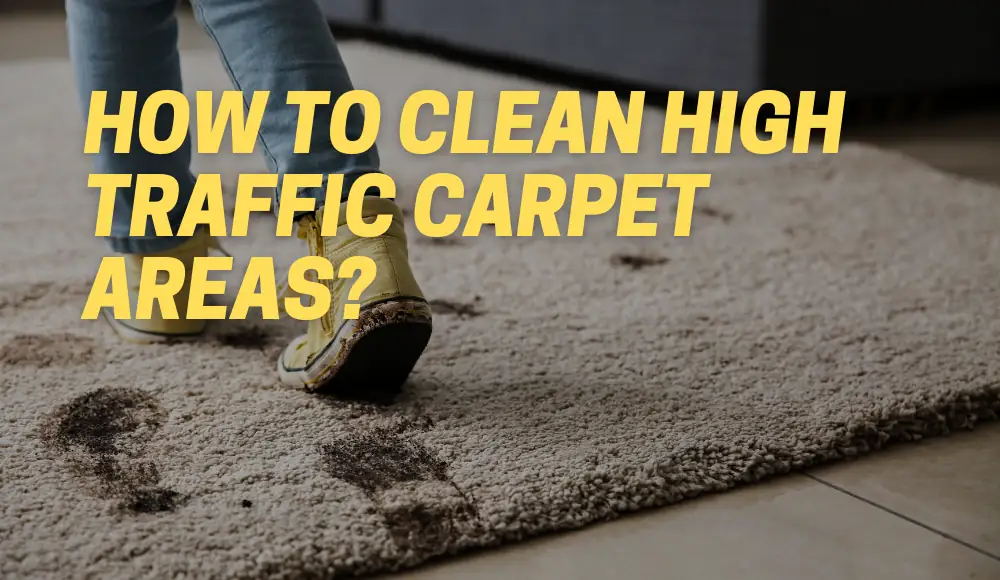Last updated on September 12th, 2023 at 12:22 am
If you’re considering replacing your carpet or giving your home a fresh new look, you may be wondering whether it’s worth upgrading the padding underneath. Carpet padding, also known as underlay, plays a crucial role in the overall comfort, durability, and appearance of your carpet. In this article, we’ll delve into the world of carpet padding, discussing should you replace padding under carpet or not, when it should be replaced, how often it should be replaced, and whether it’s necessary to replace padding when replacing the carpet itself.
The Importance of Padding Under Carpet
Carpet padding is an essential part of your flooring. It’s a thick material that sits between the carpet and the subfloor to provide insulation, support, and cushioning underfoot.
Good quality padding ensures that your carpet stays in place while protecting it from damage caused by furniture, foot traffic, and other factors.
Padding comes in different materials such as foam, rubber, or fiber. The type of padding you choose depends on the type of carpet you have and your specific needs.
A high-quality pad also helps dampen the sound by absorbing noise from footsteps and other sounds in the house. It’s important to keep your carpet pad in good condition for several reasons.
Is It Worth Upgrading Carpet Padding?
When it comes to upgrading carpet padding, the answer largely depends on your personal preferences and circumstances.
However, there are several factors to consider that can help you make an informed decision.
One key benefit of upgrading carpet padding is enhanced comfort.
High-quality padding provides a cushioning effect underfoot, making your carpet feel softer and more luxurious.
If you often walk or stand on your carpeted floors for extended periods, investing in a thicker, denser padding can significantly improve your comfort level.
Moreover, upgrading carpet padding can enhance the longevity of your carpet. A good underlay acts as a protective layer, absorbing the impact of foot traffic and preventing premature wear and tear.
By reducing the stress on the carpet fibers, padding helps maintain the carpet’s appearance and extends its lifespan.
Another aspect to consider is sound insulation. Upgrading your carpet padding can reduce noise transmission, making your home quieter. This is particularly beneficial in multi-level houses or apartments where noise can easily travel between floors.
Thicker and denser padding materials are more effective at soundproofing your space.
Should You Replace Padding Under Carpet: User Advice
Here are some opinions on replacing or not carpet padding shared by users on the Internet from their own experience:
| Main Points |
|---|
| – New pad is required to uphold the manufacturer’s warranties on the new carpet. |
| – Carpet cost is higher compared to the padding. |
| – Professional cleaning of the carpet is necessary every 12-18 months to maintain the warranties. |
| – Generally, it is best to replace the carpet padding, especially if the carpet is worn out or has areas of high traffic. |
| – In low-use areas, reusing the cushion might be possible, but it could still deteriorate over time and may be compressed in areas where furniture has been placed. |
| – Unless the pad is very new, it should be replaced to ensure the quality and lifespan of the carpet. |
| – It is not always necessary to replace the pad, but consulting with a trusted carpet professional is crucial to determine if replacement is needed. |
| – Most people replace wall-to-wall carpet primarily to replace the carpet itself, not the underlayment. |
| – Carpet tends to wear out before the padding, and any damage or staining to the padding will likely affect the surface material as well. |
When Should Carpet Padding Be Replaced?
While carpet padding is designed to last for a long time, there are certain situations that warrant its replacement.
Here are a few signs that indicate it may be time to replace your carpet padding:
How can you tell if carpet padding is bad?
- Worn-out padding: Over time, carpet padding can become compressed and lose its resilience. If you notice that your carpet feels flat, lacks cushioning, or shows signs of sagging in high-traffic areas, it’s a good indication that the padding has worn out and should be replaced.
- Mold or mildew: Excessive moisture can lead to the growth of mold or mildew in the padding. If you detect a musty odor or notice any discoloration or dampness on your carpet, it’s essential to inspect the padding for signs of mold. If present, immediate replacement is necessary to prevent health issues and further damage.
- Water damage: If your carpet padding has been exposed to significant water damage, such as flooding or plumbing leaks, it’s crucial to replace it promptly. Water-soaked padding can lead to mold growth, bad odors, and even structural issues if left untreated.
- Pet accidents: Accidents happen, especially if you have furry friends at home. If your pet has repeatedly soiled the carpet, the padding may have absorbed the odor and bacteria. In such cases, it’s advisable to replace the affected padding to eliminate lingering smells and maintain a hygienic environment.
How Often Should You Replace Carpet Padding?
The frequency of carpet padding replacement depends on various factors, including the quality of the padding, the level of foot traffic, and your maintenance routine.
As a general guideline, it’s recommended to replace carpet padding every 10 to 15 years.
However, if you notice any of the signs mentioned earlier or if your carpet starts to feel less comfortable and supportive, it’s worth considering an earlier replacement.
Is It Necessary to Replace Padding When Replacing Carpet?
Do you have to replace padding when replacing carpet? It’s quite obvious question to appear when it will come renewing the carpet.
When replacing your carpet, it’s generally recommended to replace the padding as well.
Although it may seem tempting to reuse the existing padding to save costs, there are several reasons why it’s beneficial to install new padding:
- Hygiene: Over time, padding accumulates dust, allergens, and bacteria that cannot be easily cleaned. Installing new padding ensures a fresh start, minimizing the risk of allergic reactions and improving indoor air quality.
- Compatibility: Different types of carpet require specific types of padding. By replacing the padding, you can ensure that the new carpet and padding are compatible, providing optimal performance and longevity.
- Warranty: Many carpet manufacturers require the use of new padding to uphold their warranty terms. Reusing old padding may void the warranty, leaving you responsible for any potential issues that arise.
- Improved performance: Modern padding technology has advanced over the years, offering superior cushioning, sound insulation, and moisture resistance. By upgrading to new padding, you can enjoy the enhanced benefits that come with newer materials and technologies.
Can You Reuse Carpet Padding?
In some cases, you may wonder whether it’s possible to reuse carpet padding, particularly if it’s in good condition.
While reusing padding is technically feasible, it’s generally not recommended due to the reasons mentioned earlier.
Reusing padding may compromise the overall performance, hygiene, and warranty coverage of your new carpet. To ensure optimal results and satisfaction, it’s best to invest in new padding when replacing your carpet.
Can You Reuse Carpet Tack Strips?
Unlike padding, carpet tack strips can often be reused if they are still in good condition.
Tack strips are wooden strips with small nails that hold the carpet in place along the edges. If the tack strips are firmly secured to the floor and are free from damage, you can typically reuse them when installing new carpet.
However, it’s essential to inspect the tack strips carefully for any signs of rot, mold, or warping. Damaged or compromised tack strips should be replaced to ensure a secure and long-lasting carpet installation.
How Often to Replace Rug Pads?
Rug pads, which are different from carpet padding, provide cushioning and grip for area rugs.
While they don’t need to be replaced as frequently as carpet padding, it’s still advisable to replace them periodically. Depending on the quality and usage, rug pads generally last around 5 to 10 years.
If you notice that the rug pad has become flattened, torn, or is no longer providing adequate cushioning or grip, it’s time to consider replacing it.
What is the Average Cost of Carpet Padding?
The cost of carpet padding can vary depending on factors such as the quality of the padding, the size of the area to be carpeted, and regional pricing variations.
The average replace carpet padding cost is between $0.50 and $2.50 per square foot. It’s worth noting that investing in higher-quality padding may come with a higher price tag, but it can provide long-term benefits in terms of comfort, durability, and insulation.
Is Expensive Carpet Underlay Worth It?
When choosing carpet padding, it’s essential to strike a balance between quality and cost. While expensive carpet underlay may offer superior features and performance, it may not always be necessary for every situation.
Factors such as the carpet type, foot traffic level, and personal preferences should be taken into account when deciding on the appropriate padding.
If you have a high-traffic area or require additional soundproofing, investing in a higher-quality, more expensive carpet underlay can be worth it.
On the other hand, if you have a low-traffic area or are working with a limited budget, there are affordable padding options available that still provide adequate comfort and support.
FAQs
How long should carpet underlay last?
Carpet underlay, or padding, typically lasts between 10 to 15 years. However, it’s important to monitor the condition of the padding and replace it if it shows signs of wear, mold, or water damage.
Is carpet or padding more important?
Both carpet and padding are important for a comfortable and durable flooring surface. While carpet provides visual appeal and texture, padding offers cushioning, support, and insulation. The combination of quality carpet and appropriate padding ensures the best overall performance.
Does carpet padding have any insulation value?
Yes, carpet padding provides insulation value by reducing heat loss and sound transmission. Thicker and denser padding materials offer better insulation properties, helping to keep your space warmer and quieter.
Can I Install New Padding Myself?
While some homeowners may be tempted to install new padding themselves as a way to save money on installation costs, it’s generally not recommended. Installing new padding requires special tools such as a power stretcher and knee kicker that most homeowners don’t have at their disposal.
Additionally, proper installation techniques are crucial for ensuring that your carpet remains properly supported over time.
Poorly installed pads can lead to unevenness in carpets or cause them to come loose from tack strips prematurely. Replacing worn-out pads for maintaining a healthy home environment is very important for prolonging the life of carpets.
Make sure you choose high-quality pads and have them installed by professionals. By doing so, you’ll enjoy the full benefits of having a comfortable, well-padded carpet that will last for years to come.
Conclusion
In conclusion, carpet padding plays a vital role in the overall quality and longevity of your carpet.
Upgrading the padding can enhance comfort, extend the life of your carpet, and provide sound insulation benefits. It’s important to consider the signs that indicate when carpet padding should be replaced, and in most cases, it’s advisable to replace the padding when replacing the carpet itself.
While carpet tack strips can often be reused, it’s generally recommended to install new padding for optimal performance and hygiene.
By understanding the importance of carpet padding and making informed decisions, you can create a comfortable and durable flooring surface for your home or office.



